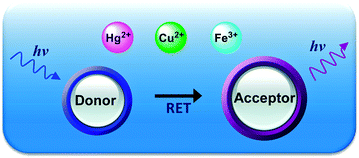Resonance energy transfer-based fluorescent probes for Hg2+, Cu2+ and Fe2+/Fe3+ ions
Abstract
Resonance energy transfer (RET) between donor–acceptor architecture is an important physical mechanism which is used enormously for the development of fluorescent probes. The unique advantage of RET is its ability to transfer energy non-radiatively between molecules over biologically relevant distances. The distance dependency of RET makes this approach suitable for bioanalysis such as distances between biomolecules and molecular level interactions, both in vitro and in vivo. In addition, RET is a proficient approach for the development of fluorescent probes with ratiometric measurements. In the recent years, resonance energy transfer has been extensively applied for the design of fluorescent sensors for different types of analytes such as metal ions, anions, reactive oxygen species and molecules of biological interest. In this review, our aim is to highlight the applications of resonance energy transfer mechanisms, i.e. Förster or fluorescence resonance energy transfer (FRET) and through-bond energy transfer (TBET) for the development of fluorescent probes, mainly for Hg2+, Cu2+ and Fe2+/Fe3+ ions.


 Please wait while we load your content...
Please wait while we load your content...